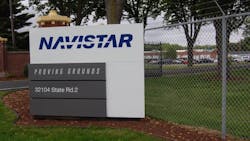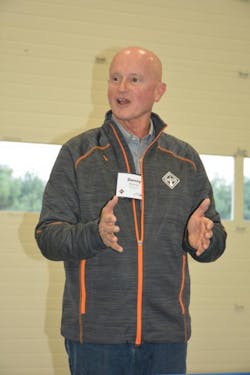At a Navistar ride and drive event held at its proving grounds in New Carlisle, IN, this week, company executives told Fleet Owner that the partnership agreement with Volkswagen Truck & Bus is off to a “robust start,” with both meshing well from the get-go.
“You would think there would be a lot of cultural differences, but surprisingly there’s not much,” said David Majors, vice president of product development.
“I think the lines have been set up in the contract so we know what our jobs are, and now it’s just about executing, so there’s not a lot of ‘our stuff is better than your stuff,’” he explained. “It’s more ‘this is what we’re going to use and this is the direction we’re going to go.’ Adapting their products for the U.S. market isn’t as challenging as we originally thought, so it’s moving along pretty well and we’re confident we’re going to have something good.”
Navistar announced at the North American Commercial Vehicle (NACV) show in Atlanta that it plans to develop fully integrated diesel big bore powertrains in conjunction with VW for the North American market in 2021.
VW last year agreed to purchase a 16.94% stake in Navistar– a deal that formally closed back in March – and at the NACV show, the companies also said they will develop an electric-powered, medium-duty vehicle for the U.S. and Canada in late 2019 or early 2020.
“The Volkswagen alliance will do two things for us,” explained Denny Mooney, Navistar’s senior vice president of global product development. “Number one, it opens us up to a lot of European technologies we hadn’t had access to. I’ve met with counterparts from Scania and MAN, the two companies that make up the VW heavy truck business, so we’re already working on new technologies for the next few years.”
He added that Navistar’s 13-liter engine is a version of the MAN engine and that “bigger powertrain opportunities” will soon open up, giving Navistar more scale and technology.
“European technology standards aren’t much different than U.S. standards, so a lot of the emissions technology is common,” Mooney noted. “The development cost you can spread amongst multiple companies. That lowers our cost and makes our products more affordable.”
Steve Gilligan, Navistar’s vice president of product and vocational marketing, explained that there were further benefits from the alliance with VW than simply co-manufacturing trucks.
“The first place we’ve seen a significant change is from the supply side, because obviously they’re a global company,” he said. “They bring a global scale, and so our purchasing people have had a lot of meetings looking for opportunities.”
Whether that manifests itself in anything from tires and collision mitigation systems to cameras and lighting technology, all of those areas are “open right now” for review with a lot of opportunities emerging, Gilligan added.
“Think of the global scale they bring just on camera technology versus our scale on trucks,” he continued. “The whole truck market is going to be 300,000 [units] next year. Even on medium-duty trucks, more and more customers are asking for things like cameras that face down for security and a visibility standpoint. So we’re looking for things that we can leverage, possibly taking the technology they’re using in the passenger car market and migrating it over to the light and medium truck market as well.”
Mooney concluded by relating the opportunities for Navistar engineers to grow is tremendous.
“It’s an exciting time,” he said. “A lot of our younger engineers want to get a European experience. And we’ve had Scania and MAN engineers to our proving grounds. We love their trucks and they love our trucks, and so it’s great for the engineers.”
About the Author
Michael Catarevas
Michael Catarevas is a former managing editor at FleetOwner. He wrote for the publication from 2017 to 2020.

